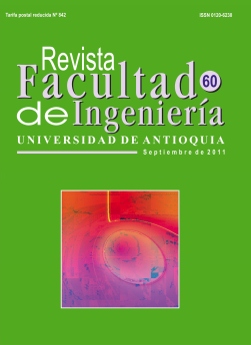Pedestrian traffic variables acquisition using computer vision
DOI:
https://doi.org/10.17533/udea.redin.13657Keywords:
pedestrian tracking, computer vision, pedestrian detectionAbstract
The traffic problem has several components that may be discussed: vehicles, pedestrians and the interaction between them. This paper proposes a method for acquisition of pedestrian traffic variables, using computer vision techniques. Isolated pedestrians, groups of pedestrians and vehicles at the scene are detected from a video sequence, using a background model. Pedestrians are tracked on the image using their shape and optical flow. Counting is done on any area of the scene to estimate the flow and direction of movement. The proposed method can be configured under different perspectives from a set of examples. The experimental results on crosswalks show that this method allows estimating the variables of interest in complex scenes.
Downloads
References
DANE. “Estadísticas vitales”. Disponible en: http://www.dane.gov.co/files/investigaciones/poblacion/defunciones/Defunciones_causa_externa_2008.xls. Recuperado: marzo de 2009.
Fondo de Prevención Vial. Accidentalidad vial en Colombia 2007. 2007. pp. 13.
World Health Organization. World report on road traffic injury prevention: summary. Geneva. 2004. pp. 1-9.
G. Urrego, F. Calderón, A. Forero, J. Quiroga. “Adquisición de variables de tráfico vehicular usando visión por computador”. Revista de Ingeniería, Universidad de los Andes. Vol. 30. 2009. pp. 7-15. DOI: https://doi.org/10.16924/revinge.30.1
J. Berclaz, F. Fleuret, P. Fua. “Robust people tracking with global trajectory optimization.” Proc. of the IEEE Conference on Computer Vision and Pattern Recognition. Vol. 1. 2006. pp. 744-750.
K. Terada, D. Yoshida, S. Oe, J. Yamaguchi. “A method of counting the passing people by using the stereo images.” Proc. of the IEEE International Conference on Image Processing. Vol. 2. 1999. pp. 338-342. DOI: https://doi.org/10.1109/ICIP.1999.822913
S. Velipasalar, Y. L. Tian, A. Hampapur. “Automatic counting of interacting people by using a single uncalibrated camera.” Proc. of the IEEE International Conference on Multimedia and Expo. Vol. 1. 2006. pp. 1265-1268. DOI: https://doi.org/10.1109/ICME.2006.262768
N. Dalal, B. Triggs. “Histograms of oriented gradients for human detection.” Proc. of the IEEE Conference on Computer Vision and Pattern Recognition. Vol. 1. 2005. pp. 886-893.
B. Leibe, E. Seemann, B. Schiele. “Pedestrian detection in crowded scenes.” Proc. of the IEEE Conference on Computer Vision and Pattern Recognition. Vol. 1. 2005. pp. 878-885.
B. Wu, R. Nevatia. “Detection of multiple, partially occluded humans in a single image by Bayesian combination of edge part detectors.” Proc. Of the IEEE International Conference on Computer Vision. Vol. 1. 2005. pp. 90-97. DOI: https://doi.org/10.1109/ICCV.2005.74
S. Khan, M. Shah. “Tracking people in presence of obstacles.” Proc. of the First Asian Conference on Computer Vision.Vol. 1. 2000. pp. 1132-1137.
G. G. Lee, B. S. Kim, W. Y. Kim. “Automatic estimation of pedestrian flow.” Proc. of the First ACM/IEEE Int. Conference on Distributed Smart Cameras. Vol. 1. 2007. pp. 291-296 DOI: https://doi.org/10.1109/ICDSC.2007.4357536
O. Masoud, N. P. Papanikolopoulos. “A novel method for tracking and counting pedestrians in real-time using a single camera.” IEEE Transactions on Vehicular Technology. Vol. 50. 2001. pp. 1267-1278. DOI: https://doi.org/10.1109/25.950328
P. Viola, M. J. Jones, D. Snow. “Detecting pedestrians using patterns of motion and appearance”. Proc. Of the IEEE Int. Conf. on Computer Vision. Vol. 2. 2003. pp. 734-741. DOI: https://doi.org/10.1109/ICCV.2003.1238422
O. Sidla, Y. Lypetskyy, N. Brandle, S. Seer. “Pedestrian detection and tracking for counting applications in crowded situations.” Proc. of the IEEE International Conference on Video and Signal Based Surveillance. Vol. 1. 2006. pp. 70-75. DOI: https://doi.org/10.1109/AVSS.2006.91
K. Kim, T. Chalidabhongse, D. Harwood, L. Davis. “Real-time foreground–background segmentation using codebook model.” Real-Time Imaging. Vol. 11. 2005. pp. 167-256. DOI: https://doi.org/10.1016/j.rti.2004.12.004
J. Shi, C. Tomasi. “Good features to track.” Proc. Of the IEEE Conference on Computer Vision and Pattern Recognition.Vol. 1. 1994. pp. 593-600.
R. O. Duda, P. E. Hart. “Use of the Hough transformation to detect lines and curves in pictures”. Communications of the ACM. Vol. 15. 1972. pp. 11-15. DOI: https://doi.org/10.1145/361237.361242
J. Y. Bouguet. “Pyramidal implementation of the Lucas Kanade feature tracker – Description of the algorithm.” Intel Corporation – Microprocessor Research Labs. 2000.
R. Greene-Roesel, M. C. Diogenes, D. Ragland, L. Lindau. “Effectiveness of a Commercially Available Automated Pedestrian Counting Device in Urban Environments: Comparison with Manual Counts.” Transportation Research Board 87th Annual Meeting. 2008. pp. 16.
P. Felzenszwalb, R. Girshick, D. McAllester, D. Ramanan. “Object Detection with Discriminatively Trained Part-Based Models.” IEEE Transactions on Pattern Analysis and Machine Intelligence. Vol 32. 2010. pp. 1627-1645. DOI: https://doi.org/10.1109/TPAMI.2009.167
Downloads
Published
How to Cite
Issue
Section
License
Copyright (c) 2018 Revista Facultad de Ingeniería

This work is licensed under a Creative Commons Attribution-NonCommercial-ShareAlike 4.0 International License.
Revista Facultad de Ingeniería, Universidad de Antioquia is licensed under the Creative Commons Attribution BY-NC-SA 4.0 license. https://creativecommons.org/licenses/by-nc-sa/4.0/deed.en
You are free to:
Share — copy and redistribute the material in any medium or format
Adapt — remix, transform, and build upon the material
Under the following terms:
Attribution — You must give appropriate credit, provide a link to the license, and indicate if changes were made. You may do so in any reasonable manner, but not in any way that suggests the licensor endorses you or your use.
NonCommercial — You may not use the material for commercial purposes.
ShareAlike — If you remix, transform, or build upon the material, you must distribute your contributions under the same license as the original.
The material published in the journal can be distributed, copied and exhibited by third parties if the respective credits are given to the journal. No commercial benefit can be obtained and derivative works must be under the same license terms as the original work.










 Twitter
Twitter